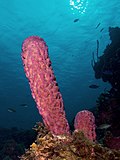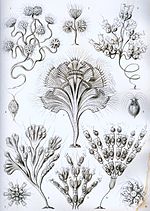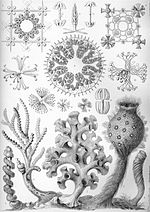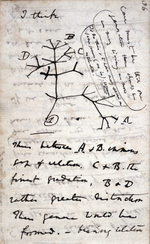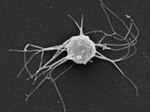Pinacocyte Choanocyte Lophocyte Porocyte Oocyte Archeocyte Sclerocyte Spicule Water flow Choanocytes (also known as "collar...
3 KB (349 words) - 18:54, 2 November 2024
with choanocytes, cells with whip-like flagella.: 29 However, a few carnivorous sponges have lost these water flow systems and the choanocytes.: 39 ...
132 KB (13,366 words) - 21:15, 29 October 2024
structure. Regardless of body plan or class, the spongocoel is lined with choanocytes, which have flagella that push water through the spongocoel, creating...
1 KB (186 words) - 10:46, 18 March 2022
based on an increasingly complex skeletal system and compartmentalized choanocytes. A few sources (such as the Treatise on Invertebrate Paleontology, 2004)...
3 KB (297 words) - 17:40, 3 July 2024
distinguished from the rather similar Sycon raphanus by the fact that the choanocyte chambers are not fused but are free from each other. Sycon ciliatum is...
3 KB (183 words) - 07:46, 22 January 2023
lack true tissues. They have two cell layers: the pinacoderm and the choanocyte layer. The pinacoderm layer is the epidermal layer that consists of pinacocyte...
21 KB (2,064 words) - 07:02, 12 November 2024
amoebocytes as well as other sponge cells including the phylum specific choanocyte. These cells move within the walls of a sponge and form spicules. Tschinkel;...
2 KB (224 words) - 16:35, 2 August 2024
myxogastrids Opisthokonta: most metazoans (male gametes, epithelia and choanocytes), chytrid fungi (zoospores and gametes) Excavata: some acrasids (Pocheina...
13 KB (1,337 words) - 12:10, 5 November 2024
and some morphological characteristics, like the common presence of choanocytes, now unanimously support a common origin. Traditionally, eumetazoans...
12 KB (1,211 words) - 03:58, 24 November 2024
Carboniferous, Nevada. Spermatocytes develop from the transformation of choanocytes and oocytes arise from archeocytes. Repeated cleavage of the zygote egg...
24 KB (2,477 words) - 12:52, 22 November 2024
known as archaeocytes, capable of transforming into the feeding cells or choanocytes. Amoeboid stages also occur in the multicellular fungus-like protists...
51 KB (4,923 words) - 03:15, 16 November 2024
water is subsequently circulated through the sponge by cells called choanocytes which have hair-like structures that move the water through the sponge...
57 KB (6,635 words) - 10:31, 5 November 2024
found either in specialized cells of multicellular organisms (e.g., the choanocytes of sponges, or the ciliated epithelia of metazoans), as in ciliates and...
66 KB (7,259 words) - 04:52, 19 November 2024
resembles Sycon ciliatum but can be distinguished by the fact that the choanocyte chambers are fused. Sycon raphanus is found along the western fringes...
3 KB (219 words) - 21:21, 1 October 2024
choanoflagellates, collared flagellates whose cell morphology is similar to the choanocyte cells of certain sponges. Molecular studies place animals in a supergroup...
6 KB (720 words) - 23:21, 7 October 2024
organelles ("organs" within cells) and other substances. Instead of choanocytes, these bridges have further syncytia, known as choanosyncytia, which...
20 KB (2,304 words) - 15:07, 8 October 2024
of early animals? Eocyathispongia: is it an early sponge? Did it have choanocytes? Vernanimalcula guizhouena: is this fossil organism an early bilaterian...
31 KB (3,316 words) - 01:06, 7 October 2024
Trichoplax adhaerens evolved by reduction of the collars in the collar cells (choanocytes) of sponges as the hypothesized ancestors of the Placozoa abandoned a...
57 KB (5,803 words) - 21:10, 11 November 2024
in several types of cells in sponges (amoebocytes, pinacocytes, and choanocytes). The number of contractile vacuoles per cell varies, depending on the...
10 KB (1,304 words) - 12:50, 2 July 2024
temporary colonies from a free-living unicellular stage. Sponges have choanocytes, cells that resemble single-celled choanoflagellates, providing an indication...
54 KB (984 words) - 23:35, 7 November 2024
entering the cytosol where it would damage actin. After production in the choanocytes, the latrunculin is transferred via the archeocytes to the vulnerable...
20 KB (2,172 words) - 05:50, 4 November 2024
choanoderm is a type of cell layer composed of flagellated collar cells, or choanocytes, found in sponges. The sponge body is mostly a connective tissue; the...
2 KB (181 words) - 03:30, 16 March 2024
plankton, with an osculum as the opening which water leaves through, and choanocytes trap food particles. This species is frequently colonized by Umimayanthus...
9 KB (736 words) - 20:36, 1 October 2024
recorded the morphological similarities of choanoflagellates and sponge choanocytes and proposed the possibility of a close relationship as early as 1841...
42 KB (4,206 words) - 08:08, 9 November 2024
Choanoflagellata. The kinetid structure of Ministeria is similar to that of the choanocytes of the most deep-branching sponges, differing essentially from the kinetid...
4 KB (417 words) - 02:17, 17 November 2024
Australia. Species have a simple tubular body with a large atrium, and choanocyte chambers which are either elongated, spherical or both. The following...
2 KB (176 words) - 06:47, 9 March 2022
asconoid. The inner structure of this animal is covered by a layer of choanocytes. Euplectella is a member of the class Sclerospongiae or glass sponges...
11 KB (1,152 words) - 22:10, 9 February 2024
to the smooth, slightly slimy surface. This sponge has long tubular, choanocyte chambers, which are sometimes branched, and no spicules. The oscula are...
4 KB (489 words) - 04:29, 23 June 2023
discovery of "neuroid" cells specialized in coordination of digestive choanocytes in Spongilla, the origin of neurons in the phylogenetic tree of life...
22 KB (2,624 words) - 20:58, 28 February 2024
sponge, supported on the choanoskeleton, the structure that contains the choanocytes. Choanoderm Boury-Esnault, Nicole; De Vos, Louis; Donadey, Claude; Vacelet...
1 KB (91 words) - 21:05, 30 October 2023


